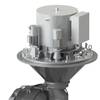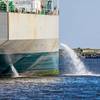LNG on the Rise
As the world’s economies search for sustainable, reliable, renewable energy sources, they are also more closely examining a range of fossil fuels to find the cleanest, least harmful of those to cut carbon emissions and improve air quality in the process.
In the drive to cut carbon emissions, interest in liquefied natural gas (LNG) is growing. LNG is being looked at not only as fuel for generating electricity and heat, but also as a fuel for powering marine vessels, road vehicles and trains. With the recent development of abundant shale gas deposits in the United States, the LNG market is really set to take off.
The common method for transporting natural gas worldwide is to liquefy it so it takes up less volume and can be transported in specialized LNG carrier vessels. When cooled to –161°C (–259°F) it is transformed to a liquid state that occupies only one-six-hundredth the volume of the gas equivalent. But transferring LNG comes with a host of risks due to the cryogenic characteristics when the gas is in its liquid form – for example, a leak can crack a ship’s deck and hull.
Trelleborg has been helping to minimize these LNG risks for more than 15 years. “We have world-leading technology,” said David Pendleton, Business Development Director at the Trelleborg Offshore & Construction marine operation in the U.K.
Indeed, the majority of the world’s LNG cargo fleet and terminals are equipped with Trelleborg SeaTechnik Ship Shore Link (SSL) technology, a system for communicating emergency shutdown (ESD) signals, telephone and process data required when cargo transfer is undertaken from ship to shore and from shore to ship.
While international regulations require ships and terminals to have two independent links available and also present a minimum of one system for compatibility requirements for passing along mutual ESD signals between ship and shore, the Trelleborg system can handle all known types of links from fiber optic to electric (five different types) and pneumatic.
Trelleborg also offers a 24/7 service team to ensure any system downtime is minimized. “If you have a ship costing you $100,000 a day to charter and a cargo of several million dollars, it’s an expensive boat sitting there doing nothing if you can’t connect the ship and shore together to allow transfer of the LNG cargo,” says Gordon Graham, Operation Director at the Trelleborg Offshore & Construction marine operation in the U.K. “Our technology and our team make sure that will not happen.”
Further development in its SSL technology for floating storage and regasification units (FSRU), specialist vessels that convert LNG stored into their tanks to gas for transport out into a gas network, are ongoing at Trelleborg. For these vessels, the Trelleborg SSL simultaneously transmits both the ESD signals for the gas output system and the ESD signals associated with the liquid transfer into the vessel. Such vessels are in demand where building a gas processing plant would not be economically viable or practical and Trelleborg currenly has a very large share of the market.
The System
1. To shore SSL system
2. Electric and fiber optic cable reels
3. Cable and hose reels
4. Port ship side box
5. Shore umbilical
6. Cables and tubing
7. Electrical equipment room
8. Ship shore link enclosure
9. Port ITT cannon box
10. Emergency shutdown system
11. Starboard ITT cannon box
12. Mooring load monitor repeater
13. Pabx, public & hotline telephones
14. Cargo control room
15. IAS (third party supply)
16. Cables and tubing
17. Port/starboard ship side box
Trelleborg’s Product for LNG
Trelleborg not only supplies oil and gas transfer technology for the LNG market but it also designs and manufactures products for vessel docking, mooring and monitoring systems for LNG marine terminals, including fenders.
Trelleborg’s cryogenic hoses contribute to safe LNG offloading while other industrial hoses are used for chemical and petrochemicals. Trelleborg also supplies sealing solutions for LNG, for example for liquid loading and unloading equipment.
Shale Gas
The U.S. shale oil boom has produced a shale gas boom as well, meaning that U.S. port facilities that once handled only the import of liquefied natural gas are preparing to handle LNG export as well. Trelleborg is at the cutting edge in assuring the safety of such export operations. In 2013, the U.S. Coast Guard LNG team called in Trelleborg to work with it at a terminal in Port Arthur, Texas, providing training on ship-to-shore safety monitoring links and demonstrating how such systems would function.
“It was the first time the coast guard had done this training, and Trelleborg was delighted to work with them,” says David Pendleton at the Trelleborg Offshore & Construction marine operation in the U.K. “We’re the leader in SSL technology, so it makes sense they’re doing it with us to ensure best practice could be shared. Shale presents a great opportunity for all those involved in the LNG industry. With the growth of shale gas, U.S. gas producers are moving from an import to an export market, which will generate many more ship movements at U.S. terminals. Therefore it is vital for key players in the industry such as the U.S. Coast Guard to have the best understanding of the technology being used at these terminals.”










